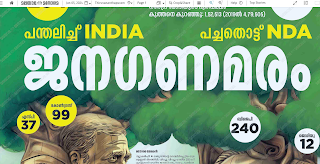How different is copy editing from the editing you do as part of your technical writing? Some might feel that it is nothing compared to what is done in technical writing. Others might say a lot can be carried from newspaper copy editing to technical editing. Others might say both are miles apart.
I can't help from saying that there is an awful lot of misunderstanding about a copy editor's work in newspapers. On the internet, one of the best quoted or linked source of what a copy editor does is at The Slot. Click here to read The Slot's article on What Exactly is a Copy Editor. Here, I don't intend to pass judgements on which one is more challenging and complex, or which one is easy.
Let me put my perspective what a copy editor (sub editor in Indian parlance) does. Firstly, it is neither a "mere" editing job, nor a proofreading job. It is job with lots of responsibility, pressure, and requires syncing with the editorial team, the reporting team, the graphics team, advertising, and even the sales and marketing team.
A copy editor, as a journalist, needs to know something about everything under the sun. Knowing everything means learning new subjects and keeping track of the happenings in the English language and the profession. (Unlike in the media, a technical writer can focus on the particular domain or tool based on his or her job requirements. He or she is not supposed to know each and every domain).
When a copy editor walks in and logs into his or her machine, there will be nothing on the "queue" to edit. Stories filed by reporters, correspondents, senior journalists, start to flow in slowly, often late in the evening. Of the stories that come in, one has to be selected as the lead or main story. A lead story appears more prominent on the page, usually at the top left or right, spreads across many columns, and is set in the biggest headline style. Editing is based on the house style and the copy editor has to keep an eye on the legal implications of stories.
While most of the day is spent on editing news stories, an hour or more is left to design or make pages using a software like QuarkXPress. A copy editor usually makes more than one page. It is here that the skills get really tested.
The reason is the page. A copy editor does not have any control of the preliminary design of the page. You can consider the page as the template we often talk about in technical writing. Typically, a page is divided into 7-8 columns. This template is initially drafted by the "ad" department. Pages will have ads, which take a few columns at the bottom of the page, or half the page. The more the ad space is, the more happy the copy editor is. This means that the "template" a copy editor works on is never the same. A copy editor actually works on widely different templates daily.
The templates are different, but the deadline is the same. The templates are different, but the level of edits required for stories are different. Moreover, every page requires photos to balance the weight on the page. And if the ad department comes with a last minute change, you can imagine the pressure and the mess the copy editor can be in.
The newspaper industry is the only industry that releases a new product every day. In the mornings, you read the news edited by copy editors and view the pages designed by the copy editors last night.
Subscribe to:
Post Comments (Atom)
Newspaper front pages - June 5
Some images of front pages of newspapers after votes were counted on June 4, 2024 after a ridiculously long parliament elections. Did the ...

-
Some images of front pages of newspapers after votes were counted on June 4, 2024 after a ridiculously long parliament elections. Did the ...
-
The following classification of newspaper headlines is based on my journalism notes. They are from the point of page layout. Flush Left -Hea...
-
Leaders who pick and quibble and snipe are people who fear that a Mojofied team might threaten their own petty power. If your environment is...

No comments:
Post a Comment